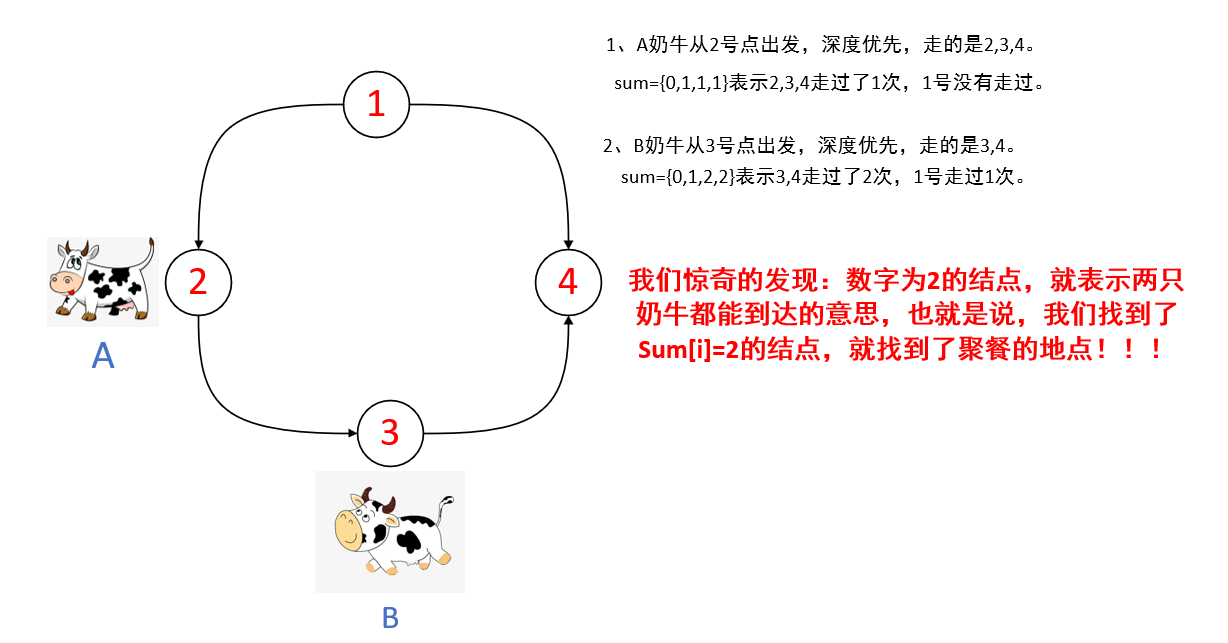题目传送门
一、题意分析

二、bfs解法
1、链式前向星
#include <bits/stdc++.h>
using namespace std;
const int N = 10010;
queue<int> q;
bool st[N];
int n;
int m;
int k;
int a[N];
int sum[N];
int ans;
int idx, head[N];
struct Edge {
int to, next;
} edge[N];
int add(int from, int to) {
edge[++idx].to = to;
edge[idx].next = head[from];
head[from] = idx;
}
int main() {
cin >> k >> n >> m;
for (int i = 1; i <= k; i++) cin >> a[i];
for (int i = 1; i <= m; i++) {
int x, y;
cin >> x >> y;
add(x, y);
}
for (int i = 1; i <= k; i++) {
memset(st, 0, sizeof(st));
q.push(a[i]);
st[a[i]] = true;
while (!q.empty()) {
int x = q.front();
q.pop();
for (int i = head[x]; i; i = edge[i].next) {
int to = edge[i].to;
if (!st[to]) {
st[to] = true;
q.push(to);
}
}
}
for (int j = 1; j <= n; j++) sum[j] += st[j];
}
for (int i = 1; i <= n; i++)
if (sum[i] == k) ans++;
printf("%d", ans);
return 0;
}
2、邻接表
#include <bits/stdc++.h>
using namespace std;
const int N = 10010;
queue<int> q;
bool st[N];
int n;
int m;
int k;
int a[N];
int sum[N];
vector<int> p[N];
int ans;
int main() {
cin >> k >> n >> m;
for (int i = 1; i <= k; i++) cin >> a[i];
for (int i = 1; i <= m; i++) {
int x, y;
cin >> x >> y;
p[x].push_back(y);
}
for (int i = 1; i <= k; i++) {
memset(st, 0, sizeof(st));
q.push(a[i]);
st[a[i]] = true;
while (!q.empty()) {
int x = q.front();
q.pop();
for (int to:p[x]) {
if (!st[to]) {
st[to] = true;
q.push(to);
}
}
}
for (int j = 1; j <= n; j++) sum[j] += st[j];
}
for (int i = 1; i <= n; i++)
if (sum[i] == k) ans++;
printf("%d", ans);
return 0;
}
3、邻接矩阵
#include <bits/stdc++.h>
using namespace std;
const int N = 10010;
queue<int> q;
bool st[N];
int n;
int m;
int k;
int a[N];
int sum[N];
int g[N][N];
int ans;
int main() {
cin >> k >> n >> m;
for (int i = 1; i <= k; i++) cin >> a[i];
for (int i = 1; i <= m; i++) {
int x, y;
cin >> x >> y;
g[x][y] = 1;
}
for (int i = 1; i <= k; i++) {
memset(st, 0, sizeof(st));
q.push(a[i]);
st[a[i]] = true;
while (!q.empty()) {
int x = q.front();
q.pop();
for (int i = 1; i <= n; i++)
if (g[x][i] && !st[i]) {
st[i] = true;
q.push(i);
}
}
for (int j = 1; j <= n; j++) sum[j] += st[j];
}
for (int i = 1; i <= n; i++)
if (sum[i] == k) ans++;
printf("%d", ans);
return 0;
}
三、dfs解法
1、链式前向星
#include <bits/stdc++.h>
using namespace std;
const int N = 1010 * 1010;
int n;
int m;
int k;
int ans;
int a[N];
int sum[N];
bool st[N];
int idx, head[N];
struct Edge {
int to, next;
} edge[N];
int add_edge(int from, int to) {
edge[++idx].to = to;
edge[idx].next = head[from];
head[from] = idx;
}
void dfs(int x) {
st[x] = true;
sum[x]++;
for (int i = head[x]; i; i = edge[i].next) {
int v = edge[i].to;
if (!st[v]) dfs(v);
}
}
int main() {
cin >> k >> n >> m;
for (int i = 1; i <= k; i++) cin >> a[i];
for (int i = 1; i <= m; i++) {
int x, y;
cin >> x >> y;
add_edge(x, y);
}
for (int i = 1; i <= k; i++) {
memset(st, 0, sizeof st);
dfs(a[i]);
}
for (int i = 1; i <= n; i++) if (sum[i] == k) ans++;
cout << ans << endl;
return 0;
}
2、邻接表
#include <bits/stdc++.h>
using namespace std;
const int N = 1010;
int n;
int m;
int k;
int ans;
vector<int> p[N];
int a[N];
int sum[N];
bool st[N];
void dfs(int x) {
st[x] = true;
sum[x]++;
for (int v:p[x])
if (!st[v]) dfs(v);
}
int main() {
cin >> k >> n >> m;
for (int i = 1; i <= k; i++) cin >> a[i];
for (int i = 1; i <= m; i++) {
int u, v;
cin >> u >> v;
p[u].push_back(v);
}
for (int i = 1; i <= k; i++) {
dfs(a[i]);
memset(st, false, sizeof(st));
}
for (int i = 1; i <= n; i++)
if (sum[i] == k) ++ans;
cout << ans << endl;
return 0;
}
3、邻接矩阵
#include <bits/stdc++.h>
using namespace std;
const int N = 1010;
int n;
int m;
int k;
int ans;
int g[N][N];
int a[N];
int sum[N];
bool st[N];
void dfs(int x) {
st[x] = true;
sum[x]++;
for (int i = 1; i <= n; i++)
if (!st[i] && g[x][i]) dfs(i);
}
int main() {
cin >> k >> n >> m;
for (int i = 1; i <= k; i++) cin >> a[i];
for (int i = 1; i <= m; i++) {
int u, v;
cin >> u >> v;
g[u][v] = 1;
}
for (int i = 1; i <= k; i++) {
dfs(a[i]);
memset(st, false, sizeof(st));
}
for (int i = 1; i <= n; i++)
if (sum[i] == k) ++ans;
cout << ans << endl;
return 0;
}




【推荐】国内首个AI IDE,深度理解中文开发场景,立即下载体验Trae
【推荐】编程新体验,更懂你的AI,立即体验豆包MarsCode编程助手
【推荐】抖音旗下AI助手豆包,你的智能百科全书,全免费不限次数
【推荐】轻量又高性能的 SSH 工具 IShell:AI 加持,快人一步
· 开发者必知的日志记录最佳实践
· SQL Server 2025 AI相关能力初探
· Linux系列:如何用 C#调用 C方法造成内存泄露
· AI与.NET技术实操系列(二):开始使用ML.NET
· 记一次.NET内存居高不下排查解决与启示
· 被坑几百块钱后,我竟然真的恢复了删除的微信聊天记录!
· 没有Manus邀请码?试试免邀请码的MGX或者开源的OpenManus吧
· 【自荐】一款简洁、开源的在线白板工具 Drawnix
· 园子的第一款AI主题卫衣上架——"HELLO! HOW CAN I ASSIST YOU TODAY
· Docker 太简单,K8s 太复杂?w7panel 让容器管理更轻松!